In the fast-evolving world of digital marketing, the days of relying solely on click-through rates (CTR) to measure success are fading. With user journeys becoming more complex, marketers need smarter tools that go beyond surface-level metrics. Enter Adobe’s LLM Optimizer, a cutting-edge solution unveiled at the Cannes Lions 2025 event that promises to redefine how we track and optimize performance across AI-powered platforms.
What is Adobe’s LLM Optimizer?
LLM stands for Large Language Model, the same AI framework that powers tools like ChatGPT. Adobe’s LLM Optimizer is designed to help brands create and fine-tune content that performs better in AI-generated environments, such as:
- Google’s AI Overviews
- Microsoft Copilot results
- Chatbots and virtual assistants
- Voice search queries
- AI search previews on mobile
Rather than just tracking if someone clicks a link, this optimizer helps marketers ensure their content is seen, understood, and remembered, even when users never visit a website directly.
Why Is This a Game-Changer?
💡 1. Visibility in Zero-Click Environments
With AI search results becoming more common, many users don’t click at all—they read the AI’s summary and move on. Adobe’s tool helps marketers inject the right language, format, and structure to ensure their brand is featured in these summaries.
💡 2. Multi-Channel Optimization
From emails to social media to web pages, Adobe’s optimizer evaluates content performance across platforms and suggests tailored edits for each format—maximizing efficiency for content marketers.
💡 3. Real-Time Feedback
As content is created, the optimizer offers real-time AI insights—such as tone adjustments, SEO enhancement, and content ranking potential. This shortens feedback cycles and removes guesswork.
Real-World Use Case: A Digital Marketing Agency in India
A Gurgaon-based digital marketing agency used Adobe’s LLM Optimizer to enhance visibility in Google’s AI Overviews for a skincare brand. By restructuring headings, simplifying product descriptions, and targeting conversational keywords, the brand achieved:
✅ A 27% increase in AI feature appearances
✅ Higher organic reach from voice assistants
✅ Better engagement in chatbot-based support tools
This example shows that content optimization isn’t just about algorithms—it’s about adapting to how humans interact with machines.
How Can You Use This?
- Content Creation Teams: Use the optimizer while drafting blogs or ad copy to align with LLM-friendly structures.
- SEO Specialists: Identify how your content is being summarized or ignored in AI overviews and adjust accordingly.
- Brand Managers: Ensure your message remains consistent and on-brand, even when filtered through AI-generated summaries.
Final Thoughts
In 2025, digital marketing is about relevance, readability, and reach—not just clicks. Adobe’s LLM Optimizer signals a future where brands must optimize not just for users, but for the AI agents interpreting content on their behalf.
If your marketing strategy still revolves around impressions and clicks, it’s time to evolve. Start thinking beyond the traditional funnel and explore how tools like the LLM Optimizer can future-proof your brand visibility in the age of AI.




